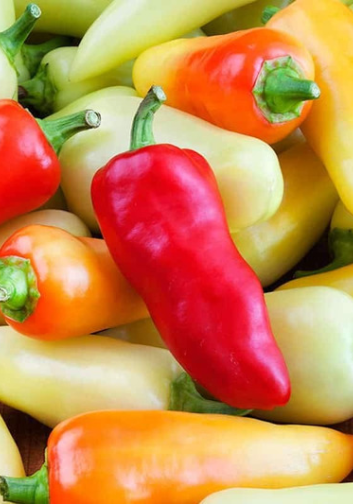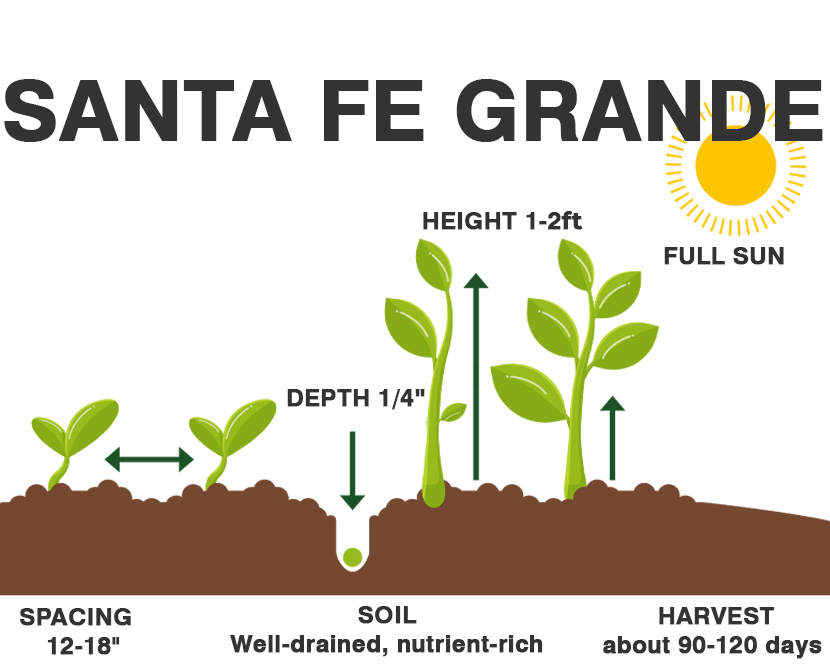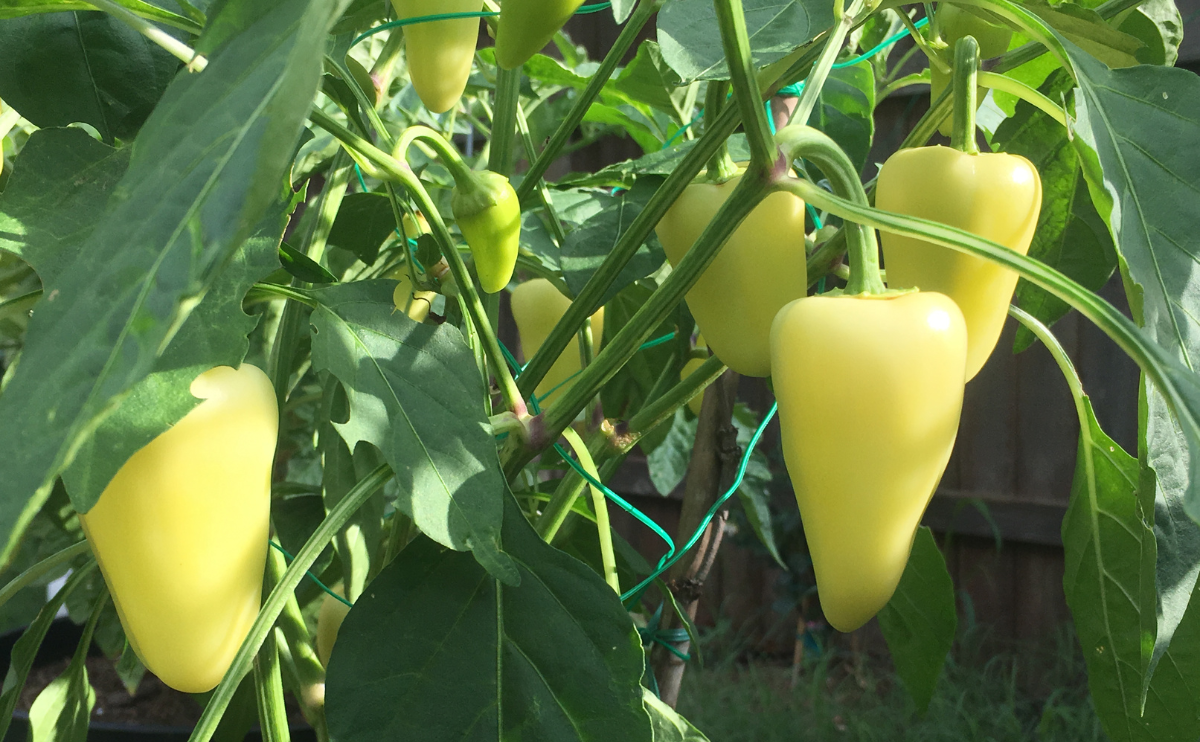A pretty chile, Santa Fe Grande pepper (also known as Guero) matures from yellow to orange-red with mild heat and slight sweetness. It works well either cooked or fresh for salads, salsas, and other dishes based on chile peppers. Plants grow about 2 feet tall and are resistant to tobacco mosaic virus.

| Common Name | Santa Fe Grande pepper |
| Botanical Name | Capsicum annuum |
| Family | Solanaceae |
| Plant Type | Perennial, vegetable |
| Size | 1–4 ft. tall, 1–2 ft. wide |
| Sun Exposure | Full sun |
| Soil Type | Moist, well-drained |
| Soil pH | Acidic, neutral |
| Bloom Time | Summer |
| Hardiness Zones | 9–11 (USDA) |

When to Plant?
This will be determined by your planting zone. There is a final frost date for each area. As a result, you can plan your gardening activities around this date. Check our Frost Dates Across North America: First & Last Frost Dates Chart. However, the date will not be the same for every plant.
How to Plant
Only home gardeners who enjoy long growing seasons in the Deep South should attempt to sow pepper seeds directly in the vegetable garden. Most of us must start our own pepper plants indoors about 8-10 weeks before transplanting, which should be done 2-3 weeks after the expected last frost.
As soon as seedlings emerge, provide plenty of light on a sunny windowsill or grow seedlings 3-4 inches beneath fluorescent plant lights turned on 16 hours per day, off for 8 hours at night. Raise the lights as the plants grow taller. Incandescent bulbs will not work for this process because they will get too hot. Most plants require a dark period to grow, do not leave lights on for 24 hours.

Seedlings do not need much fertilizer, feed when they are 3-4 weeks old using a starter solution (half strength of a complete indoor houseplant food) according to manufacturer’s directions.
If you are growing in small cells, you may need to transplant the seedlings to 3 or 4-inch pots when seedlings have at least 3 pairs of leaves before transplanting to the garden, so they have enough room to develop strong roots.
Before planting in the garden, seedling plants need to be “hardened off”. Accustom young plants to outdoor conditions by moving them to a sheltered place outside for a week. Be sure to protect them from wind and hot sun at first. If frost threatens at night, cover or brings containers indoors, then take them out again in the morning. This hardening off process toughens the plant’s cell structure and reduces transplant shock and scalding.
How to Cultivate
Keep weeds under control during the growing season. Weeds compete with plants for water, space and nutrients, so control them by either cultivating often or using a mulch to prevent their seeds from germinating.
Mulches also help retain soil moisture and maintain even soil temperatures. This is especially significant for peppers, as their roots may be easily damaged when weeding, and this can lead to blossom end rot.
Keep plants well-watered during the growing season, especially during dry spells. Plants need about 1-2″ of rain per week during the growing season. Use a rain gauge to check to see if you need to add water. It’s best to water with a drip or trickle system that delivers water at low pressure at the soil level. If you water with overhead sprinklers, water early in the day so the foliage has time to dry off before evening, to minimize disease problems. Keep the soil moist but not saturated.
Note that hot peppers tend to be hotter when they have less water and fertilizer. If they receive plenty of water and fertilizer, they may be milder than expected. Monitor for pests and diseases. Check with your local Cooperative Extension Service for pest controls recommended for your area.
Try planting pepper plants near tomatoes, parsley, basil, and carrots in your home vegetable garden. Don’t plant them near fennel or kohlrabi. Peppers are very colorful when in full fruit and combine well with green herbs, okra, beans and cucumber fences in the garden bed.
How to Harvest
Once your Santa Fe Grande Pepper plants have flowered, they will soon begin producing small, 3 to 4 inch fruits. The peppers can be harvested successfully at any stage in growth, from yellow, orange and red. Simply pick the peppers, leaving the stem attached.
Hydroponics
Germination: To germinate Santa Fe Grande pepper seeds hydroponically, soak them for 24 hours, place them in a hydroponic medium, cover them lightly, keep the container warm and moist, and wait for 7-14 days for sprouts to appear.
pH range: Santa Fe Grande pepper plants prefer a slightly acidic pH range of 5.5-6.5. Ensure that the pH of the nutrient solution is maintained within this range.
EC: The electrical conductivity (EC) range for Santa Fe Grande pepper plants is between 1.8-2.2 mS/cm. This level provides enough nutrients for the plant to grow healthily.
PPM: The ideal parts per million (PPM) range for Santa Fe Grande pepper plants is between 1260-1540 ppm.
Humidity: The recommended humidity range for Santa Fe Grande pepper plants is between 60-70%. Ensure that the growing environment is well-ventilated to prevent the growth of mold or fungus.
Light hours: Santa Fe Grande pepper plants require at least 8-12 hours of light per day. During the vegetative stage, you can increase the light hours to 14-16 hours per day.
Temperature air: Santa Fe Grande pepper plants prefer a warm environment with temperatures between 70-85°F (21-29°C) during the day and 60-70°F (15-21°C) at night.
Temperature water: The water temperature for Santa Fe Grande pepper plants is between 65-75°F (18-24°C).
Overall, growing Santa Fe Grande pepper hydroponically can be a rewarding experience, and following these guidelines can help you grow healthy and vibrant plants.



